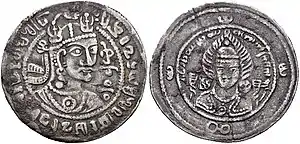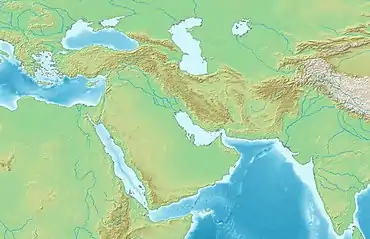Tegin Shah
Shahi Tegin, Tegin Shah or Sri Shahi (ruled 680-739 CE, known to the Chinese as 烏散特勤灑 Wusan Teqin Sa "Tegin Shah of Khorasan") was a king of the Turk Shahis, a dynasty of Western Turk or mixed Western Turk-Hephthalite origin who ruled from Kabul and Kapisa to Gandhara in the 7th to 9th centuries.[2]

Obverse: Crown with tridents and lion head. Brahmi inscription around (starting 11:00): sri-hitivira kharalava parame – svara sri sahi tiginadeva karita ("His Excellency, Iltäbar de Khalaj, worshipper of the Supreme God, His Excellency the King, the divine Lord Tegin had minted this coin"). Inside, Bactrian inscription: σρι Ϸανο Sri Shaho (His Excellency the King").[1]
Reverse: Portrait of the Iranian fire god Adur. Pahlavi inscription (starting 12:00) hpt-hpt t’ - tkyn’ hwl’s s’n MLKA ("Tegin, King of Khorasan, [year] 77). The date is in the post-Yazdegerd III era, and corresponds to 728 CE.[1]
Kabulistan was the heartland of the Turk Shahi domain, which at times included Zabulistan[3] and Gandhara.
During their rule, the Turk Shahi were in constant conflict against the eastward expansion of the Abbasid Caliphate.[2] About 650 CE, the Arabs attacked Shahi territory from the west, and captured Kabul.[2] But the Turk Shahi were able to mount a counter-offensive and repulsed the Arabs, taking back the areas of Kabul and Zabulistan (around Ghazni), as well as the region of Arachosia as far as Kandahar.[2] The Arabs again failed to capture Kabul and Zabulistan in 697-698 CE, and their general Yazid ibn Ziyad was killed in the action.[2]
From 680 CE, Shahi Tegin was the king of the Turk Shahis. His father was Barha Tegin who defeated the Arabs in 666 CE.[4] He then abdicated in 739 CE in favour of his son Fromo Kesaro, probable phonetic transcription of "Caesar of Rome" in honor of "Caesar", the title of the then East Roman Emperor Leo III the Isaurian who had defeated their common enemy the Arabs in 717 CE, and sent an embassy through Central Asia in 719 CE.[2][lower-alpha 1]
Fromo Kesaro appears to have fought vigorously against the Arabs, and his victories may have forged the Tibetan epic legend of King Phrom Ge-sar.[2]
The Turk Shahis eventually weakened against the Arabs in the late 9th century CE.[2] Kandahar, Kabul and Zabul were lost to the Arabs, while in Gandhara the Hindu Shahi took over. The last Shahi ruler of Kabul, Lagaturman, was deposed by a Brahmin minister, possibly named Vakkadeva,[5][6][7] about 850, signaling the end of the Buddhist Turk Shahi dynasty, and the beginning of the Hindu Shahi dynasty of Kabul.[8]
._After_679_in_the_style_of_the_Nezak_Huns.jpg.webp) Coin of Shahi Tegin, in the style of the Nezak Huns, whom he replaced. Bactrian legend "Sri Shaho" with tamgha, late 7th century CE.
Coin of Shahi Tegin, in the style of the Nezak Huns, whom he replaced. Bactrian legend "Sri Shaho" with tamgha, late 7th century CE.._After_679_CE.jpg.webp) Coin of Shahi Tegin (Sri Shahi).
Coin of Shahi Tegin (Sri Shahi). Coin of Shahi Tegin, imitating Khosrau II. Circa 710-720 CE
Coin of Shahi Tegin, imitating Khosrau II. Circa 710-720 CE
References
- "The Countenance of the other (The Coins of the Huns and Western Turks in Central Asia and India) 2012-2013 exhibit: Chorasan Tegin Shah". Kunsthistorisches Museum Vienna. 2012–2013. Retrieved July 22, 2017.
- Kim, Hyun Jin (19 November 2015). The Huns. Routledge. pp. 58–59. ISBN 978-1-317-34090-4.
- "15. The Rutbils of Zabulistan and the "Emperor of Rome"". Pro.geo.univie.ac.at. Kunsthistorisches Museum Vienna. Retrieved July 22, 2017.
- Vondrovec, Klaus. Coins, Art and Chronology II - The First Millennium C.E. in the Indo-Iranian Borderlands (Coinage of the Nezak). p. 183.
- D. W. Macdowall, "The Shahis of Kabul and Gandhara" Numismatic Chronicle, Seventh Series, Vol. III, 1968, pp. 189-224, see extracts in R. T. Mohan, AFGHANISTAN REVISITED ... Appendix –B, pp. 164-68
- Raizada Harichand Vaid, Gulshane Mohyali, II, pp. 83 and 183-84.
- H. G. Raverty, Tr. Tabaqat-i-Nasiri of Maulana Minhaj-ud-din, Vol. I, p. 82
- "16. The Hindu Shahis in Kabulistan and Gandhara and the Arab conquest". Pro.geo.univie.ac.at. Kunsthistorisches Museum Vienna. Retrieved July 22, 2017.
Notes
- Martin 2011, p. 127:"He received this laudatory epithet because he, like the Byzantines, was successful at holding back the Muslim conquerors."
Sources
- Martin, Dan (2011). "Greek and Islamic Medicines' Historical Contact with Tibet". In Akasoy, Anna; Burnett, Charles; Yoeli-Tlalim, Ronit (eds.). Islam and Tibet: Interactions Along the Musk Routes. Farnham, Surrey: Ashgate Publishing. pp. 117–144. ISBN 978-0-7546-6956-2.
